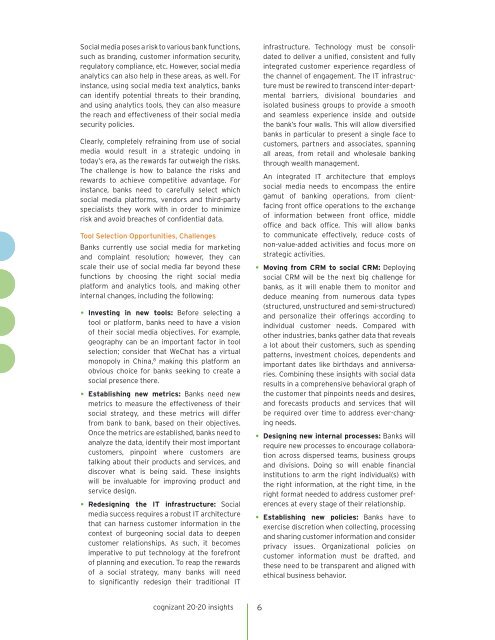How-Banks-Can-Use-Social-Media-Analytics-To-Drive-Business-Advantage
How-Banks-Can-Use-Social-Media-Analytics-To-Drive-Business-Advantage
How-Banks-Can-Use-Social-Media-Analytics-To-Drive-Business-Advantage
Create successful ePaper yourself
Turn your PDF publications into a flip-book with our unique Google optimized e-Paper software.
<strong>Social</strong> media poses a risk to various bank functions,<br />
such as branding, customer information security,<br />
regulatory compliance, etc. <strong>How</strong>ever, social media<br />
analytics can also help in these areas, as well. For<br />
instance, using social media text analytics, banks<br />
can identify potential threats to their branding,<br />
and using analytics tools, they can also measure<br />
the reach and effectiveness of their social media<br />
security policies.<br />
Clearly, completely refraining from use of social<br />
media would result in a strategic undoing in<br />
today’s era, as the rewards far outweigh the risks.<br />
The challenge is how to balance the risks and<br />
rewards to achieve competitive advantage. For<br />
instance, banks need to carefully select which<br />
social media platforms, vendors and third-party<br />
specialists they work with in order to minimize<br />
risk and avoid breaches of confidential data.<br />
<strong>To</strong>ol Selection Opportunities, Challenges<br />
<strong>Banks</strong> currently use social media for marketing<br />
and complaint resolution; however, they can<br />
scale their use of social media far beyond these<br />
functions by choosing the right social media<br />
platform and analytics tools, and making other<br />
internal changes, including the following:<br />
• Investing in new tools: Before selecting a<br />
tool or platform, banks need to have a vision<br />
of their social media objectives. For example,<br />
geography can be an important factor in tool<br />
selection; consider that WeChat has a virtual<br />
monopoly in China, 8 making this platform an<br />
obvious choice for banks seeking to create a<br />
social presence there.<br />
• Establishing new metrics: <strong>Banks</strong> need new<br />
metrics to measure the effectiveness of their<br />
social strategy, and these metrics will differ<br />
from bank to bank, based on their objectives.<br />
Once the metrics are established, banks need to<br />
analyze the data, identify their most important<br />
customers, pinpoint where customers are<br />
talking about their products and services, and<br />
discover what is being said. These insights<br />
will be invaluable for improving product and<br />
service design.<br />
• Redesigning the IT infrastructure: <strong>Social</strong><br />
media success requires a robust IT architecture<br />
that can harness customer information in the<br />
context of burgeoning social data to deepen<br />
customer relationships. As such, it becomes<br />
imperative to put technology at the forefront<br />
of planning and execution. <strong>To</strong> reap the rewards<br />
of a social strategy, many banks will need<br />
to significantly redesign their traditional IT<br />
infrastructure. Technology must be consolidated<br />
to deliver a unified, consistent and fully<br />
integrated customer experience regardless of<br />
the channel of engagement. The IT infrastructure<br />
must be rewired to transcend inter-departmental<br />
barriers, divisional boundaries and<br />
isolated business groups to provide a smooth<br />
and seamless experience inside and outside<br />
the bank’s four walls. This will allow diversified<br />
banks in particular to present a single face to<br />
customers, partners and associates, spanning<br />
all areas, from retail and wholesale banking<br />
through wealth management.<br />
An integrated IT architecture that employs<br />
social media needs to encompass the entire<br />
gamut of banking operations, from clientfacing<br />
front office operations to the exchange<br />
of information between front office, middle<br />
office and back office. This will allow banks<br />
to communicate effectively, reduce costs of<br />
non-value-added activities and focus more on<br />
strategic activities.<br />
• Moving from CRM to social CRM: Deploying<br />
social CRM will be the next big challenge for<br />
banks, as it will enable them to monitor and<br />
deduce meaning from numerous data types<br />
(structured, unstructured and semi-structured)<br />
and personalize their offerings according to<br />
individual customer needs. Compared with<br />
other industries, banks gather data that reveals<br />
a lot about their customers, such as spending<br />
patterns, investment choices, dependents and<br />
important dates like birthdays and anniversaries.<br />
Combining these insights with social data<br />
results in a comprehensive behavioral graph of<br />
the customer that pinpoints needs and desires,<br />
and forecasts products and services that will<br />
be required over time to address ever-changing<br />
needs.<br />
• Designing new internal processes: <strong>Banks</strong> will<br />
require new processes to encourage collaboration<br />
across dispersed teams, business groups<br />
and divisions. Doing so will enable financial<br />
institutions to arm the right individual(s) with<br />
the right information, at the right time, in the<br />
right format needed to address customer preferences<br />
at every stage of their relationship.<br />
• Establishing new policies: <strong>Banks</strong> have to<br />
exercise discretion when collecting, processing<br />
and sharing customer information and consider<br />
privacy issues. Organizational policies on<br />
customer information must be drafted, and<br />
these need to be transparent and aligned with<br />
ethical business behavior.<br />
cognizant 20-20 insights 6


